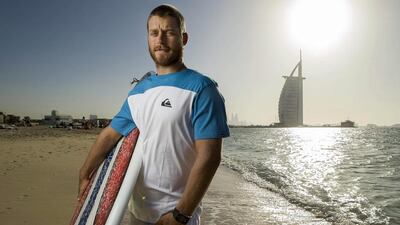DUBAI // Daniel van Dooren recalls his first surfing spot as an expanse of empty coastline overlooked by the Chicago Beach Village, the villa compound where his family used to live.
Seventeen years later, his childhood home is gone, replaced by the Madinat Jumeirah hotel development. It is just one of many changes the 28-year-old has witnessed along the emirate’s coast.
During his childhood he said there was always easy access to good fishing and the bounty was plentiful. “As soon as you would put your rod in the water, you would get a bite right away,” he said, remembering that dolphins and whale sharks could be seen easily from the beach. There was also plenty of surfing as the number of enthusiasts then was about 20 in the entire emirate.
“We could surf where we grew up on the Madinat beach. We could surf down at Mamzar, just on the border with Sharjah. We could even surf towards Jebel Ali, there were waves everywhere,” he said. “There were big waves, it was a lot more open and there were more public beaches to go to.”
Gradually, as the city grew, more of the beaches were made private. The Palm Jumeirah and Palm Jebel Ali developments were built, along with The World, resulting in the reclamation of thousands of square metres from the sea.
The mega structures also changed the way sediment moved and was deposited along the coastline. Since then, many new breakwaters have been built to stop beach erosion.
Dubai Municipality is now conducting beach restoration in Umm Suqeim 1 and 2. At the start of the project in June the municipality announced the works were expected to cost Dh35 million and would involve the use of 760,000 cubic metres of sand.
Since 2008, the municipality has been carrying out a series of beach-restoration works.
Municipal officials were not available to answer questions by The National regarding those works and the developments taking place along the coast.
For surfers such as Mr van Dooren, the changes mean less opportunities to enjoy their favourite sport. When waves do appear between November and May, they average about one metre in height compared with 1.5 to two metres before. He said the changes became most pronounced about five to seven years ago.
“There are no more waves now, except for Sunset Beach,” he lamented, pointing towards the 750-metre stretch of beach on one side of the Jumeirah Beach Hotel.
At that beach, Dubai Municipality officially allows surfers to use only a 20-metre zone.
Stronger rip tides are another issue as they run perpendicularly to the shore and can be dangerous for those who do not know how to deal with them. If caught in one a person should relax into the current rather than attempt swimming against it.
While conditions for surfing may not be what they were a decade ago, more residents, however, were trying the sport, said Mr van Dooren, who co-owns The Surf House — an equipment shop and club in Jumeirah.
During mornings when the wind is strong, about 50 to 60 people can be found at Sunset Beach queuing for the chance to catch a wave.
But they may not be able to hang 10 for much longer because plans have been announced to expand the marina of the adjacent Jumeirah Beach Hotel. The structure will probably block waves, Mr van Dooren fears. “If they do that, there is nothing left.”
A spokesman for Jumeirah said plans were under way to build a beach for the Burj Al Arab hotel and would go ahead as soon as approval was given.
“We are planning an exclusive private beach for Burj Al Arab Jumeirah and as soon as the plans are approved we will announce the details.”
vtodorova@thenational.ae

